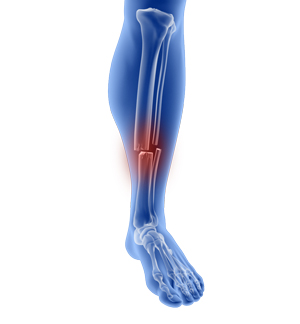
The lower leg is made up of two long bones called the tibia and fibula that extend between the knee and ankle. The tibia or shinbone is the larger of the two bones. It bears most of the body’s weight and helps form the ankle joint and knee joint.
A crack or break in the tibia is referred to as a tibial fracture. The tibia is the most frequently fractured long bone of the body. It normally takes a great amount of force for a fracture of the tibia to occur.
Fractures of the tibia vary depending on the force involved and are classified based on the location of the fracture, the pattern of the fracture, and exposure of the fracture site.
Types of Tibia Fractures
The tibia can sustain the following types of fractures:
Transverse fracture: The break is a straight, horizontal line going across the tibial shaft.
Oblique fracture: The break is noted as an angled line across the tibial shaft.
Comminuted fracture: A severe type of fracture where the bone breaks into 3 or more pieces.
Spiral fracture: A type of fracture caused by a twisting force with a fracture line that encircles the tibia.
Stable fracture: The broken pieces of the tibia are lined up correctly and stay in place as they heal.
Displaced fracture: The broken pieces of the tibia have separated and are out of alignment.
Open fracture: There is damage to the overlying skin and soft tissues exposing the fracture site.
Stress fracture: Also called a hairline fracture, this fracture appears as small thin cracks in the bone and occurs due to overuse or wear and tear.
Causes
Tibial fractures may be caused by:
- Fall from a height
- Motor vehicle collisions
- Sports injuries from twisting forces or impact
- Osteoporosis which weakens the bones
Signs and Symptoms
Signs and symptoms of tibial fractures may include:
- Severe pain in the lower leg
- Difficulty walking, kicking, or running
- Numbness or tingling in the foot
- Deformity in the lower leg
- Bone protrusion through ruptured skin
- Inability to bear weight on the leg
- Swelling around the injury site
- Bruising
- Difficulty bending the knee
Diagnosis
To diagnose a tibial fracture, your doctor will review your symptoms and medical history and conduct a thorough physical examination. To identify the type and severity of the fracture, your doctor will order imaging studies such as X-rays, CT scan, MRI or a bone scan.
Treatment
The treatment approach for tibial fractures depends upon the type and severity of the fracture as well as your condition.
Non-Surgical Treatment
Non-surgical treatment may be recommended prior to surgical treatment to protect the area until the swelling goes down and if you are not a good candidate for surgery.
Initially, a splint may be applied to provide support and comfort. Your doctor may also recommend immobilizing your leg in a rigid cast for several weeks. The cast is then replaced with a functional brace which allows some movement of the limb while still providing support and protection.
Surgical Treatment
Surgical treatment is recommended for complex or open fractures. It may involve the use of:
Plates and screws: During this procedure, the bone fragments are reduced or repositioned into their normal alignment and held together by metal plates and screws attached to the outer surface of the bone.
Intramedullary nailing: During this procedure, a metal rod is placed into the central canal of the tibia passing across the fracture site. Both ends of the intramedullary nail are screwed to the bone to keep the bones and nail in proper position while the fracture heals.
External fixation: During this procedure, screws or metal pins are placed into the bone below and above the site of the fracture. The screws and pins are secured to a bar outside the skin which holds the bones in the correct position while they heal.
Related Topics
- Knee Osteoarthritis
- Knee Fracture
- Fractures of the Tibia
- Fractures of the Patella
- Knee Pain
- Meniscal Tears
- Knee Angular Deformities
- Quadriceps Tendon Rupture
- Patellar Tendon Rupture
- Kneecap Bursitis
- Knee Injury
- Iliotibial Band Syndrome
- Unstable Knee
- Meniscal Injuries
- Osteonecrosis of the Knee
- Articular Cartilage Injury
- Loose Bodies in the Knee
- Patellar Tendinitis





